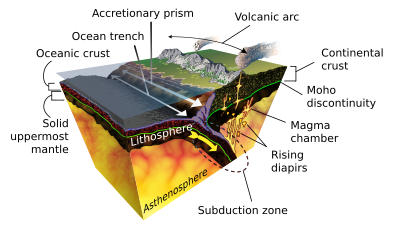
A diapir (/ˈdaɪ.əpɪər/;[1][2][3] from French diapir [djapiʁ], from Ancient Greek διαπειραίνω (diapeiraínō) 'to pierce through') is a type of intrusion in which a more mobile and ductilely deformable material is forced into brittle overlying rocks. Depending on the tectonic environment, diapirs can range from idealized mushroom-shaped Rayleigh–Taylor instability structures in regions with low tectonic stress such as in the Gulf of Mexico to narrow dikes of material that move along tectonically induced fractures in surrounding rock.
The term was introduced by Romanian geologist Ludovic Mrazek, who was the first to understand the principle of salt tectonics and plasticity. The term diapir may be applied to igneous intrusions, but it is more commonly applied to non-igneous, relatively cold materials, such as salt domes and mud diapirs. If a salt diapir reaches the surface, it can flow because salt becomes ductile with a small amount of moisture, forming a salt glacier.[4]
- ^ "diapir". The American Heritage Dictionary of the English Language (5th ed.). HarperCollins.
- ^ "diapir". Dictionary.com Unabridged (Online). n.d.
- ^ "diapir". The American Heritage Dictionary of the English Language (4th ed.). Houghton Mifflin. 2000. Archived from the original on 2006-12-08. Retrieved 2006-12-20.
- ^ Talbot, Christopher J.; Jackson, Martin P. A. (1987). "Salt Tectonics". Scientific American. 257 (2): 70–79. Bibcode:1987SciAm.257b..70T. doi:10.1038/scientificamerican0887-70. ISSN 0036-8733. JSTOR 24979445.